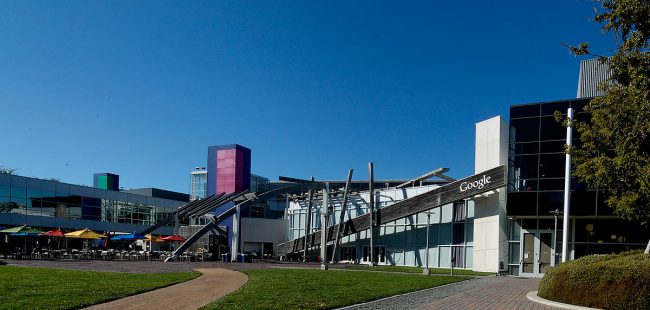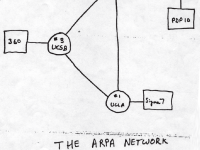
Googleplex courtyard. Image: Sebastian Bergmann, CC BY-SA 2.0 <https://creativecommons.org/licenses/by-sa/2.0>, via Wikimedia Commons
On September 27, 1998, Larry Page and Sergey Brin founded Google and began their work in the garage of businesswoman Susan Wojcicki. Up to this day, the company has become one of the most powerful in the field of search, cloud computing, productivity software, and advertising, running more than one million servers world wide.
“I think it is often easier to make progress on mega-ambitious dreams. Since no one else is crazy enough to do it, you have little competition. In fact, there are so few people this crazy that I feel like I know them all by first name.”
— Larry Page
BackRub
Larry Page and Sergey Brin, who met at Stanford University began working together on BackRub, a search engine that was not suitable to the University, because of it taking up too much bandwidth. They soon decided to found a new company and came up with the name Google, originating in the word ‘googol’, a mathematical term. It reflected their aim to organize an infinite amount of information on the Web. With the financial support by Andy Bechtolsheim and the working space in Susan Wojcicki‘s garage, they could hire their first employee and immediately began growing tremendously, building up a great reputation in Silicon Valley and beyond.
The Google Search Engine
The Google search engine uses web crawlers to follow the links it finds and tries to include many published pages in its search index. The pages are broken down by search terms and keywords. Google aims to provide users with search results sorted by relevance. The exact way the results are sorted is Google’s trade secret. Google would also like to prevent non-relevant pages from being presented unreasonably high in the results due to manipulation by the providers. These providers use search engine optimization methods for this purpose.
Page Rank
PageRank was one of the first technologies, developed at Google. It was the first technology ranking websites based on the relationships to each other instead of counting how many times the search terms appeared on the page, which most search engines did back then. Google soon succeeded with their technology, allowing them to offer further services like mail, cloud computing, social media platforms or advertising. However, Google‘s search engine stays the companies oldest and probably most successful features, dominating the market in search engines and ranked as the most visited website in history.
Nooglers
Like many other multinational companies, Google also had to face numerous skeptics and critics, mainly concerning data privacy. But besides the many opponents, Google has accumulated through the years, they are still able to fascinate and entertain the users in many ways. Google is known for its many creative Doodles or the yearly April Fool Jokes like the announcement of the Internet service TiSP (Toilet Internet Service Provider). Also the company is known for its special methods to motivating their employees. For instance, every new employee is called ‘Noogler’ and has to wear a propeller beanie cap in Google colors on their first Friday. Also the employees are able to use the company’s gym, play billiards or enjoy Google‘s health care plan. Presumably this is why the company is in the list of ideal employers, published by Universum in 2011.
The Knowledge Graph
In December 2012, Google introduced the “Knowledge Graph“, a semantic search function with which certain search terms such as animals, plants, places, buildings and famous people, but also factual terms such as sphere or hydrochloric acid display a detailed view with data and part of the introduction of the corresponding Wikipedia article. In the case of geographical or fixed terms, such as buildings or e.g. DIY store Munich, a clickable Google Maps map with marked location(s) is also displayed. Similar search terms or objects are also displayed. Google now also answers simple questions itself. For example, the answer to the question “How high is the Eiffel Tower?” is displayed above the first result. The “Knowledge Graph” provides the basis for Google Now and Google Home. The information for this comes from public encyclopaedias such as Wikipedia and the CIA World Factbook.
Where’s Google going next? | Larry Page, [7]
References and Further Reading:
- [1] Google Story
, David A. Vise, 2008
- [2] Google History on the Google Website
- [3] 20 Years Of Google Has Changed the Way We Think at Time
- [4] Google Inc. at Britannica Online
- [5] Founded in a Sillicon Valley Garage – David Packard and Hewlett-Packard, SciHi Blog
- [6] Steve Jobs – American Businessman, Inventor, and Industrial Designer, SciHi Blog
- [7] Where’s Google going next? | Larry Page, 2014, TED @ youtube
- [8] Singhal, Amit (May 16, 2012). “Introducing the Knowledge Graph: Things, Not Strings”. Google Official Blog.
- [9] Timeline of Web search engines, via Wikidata





